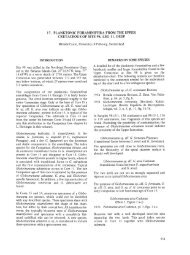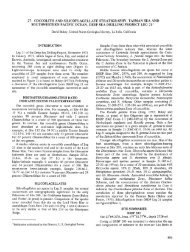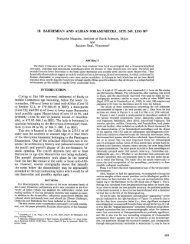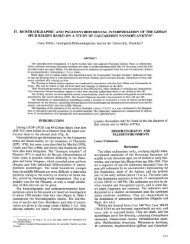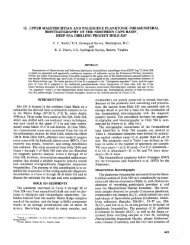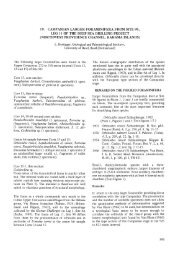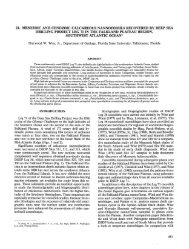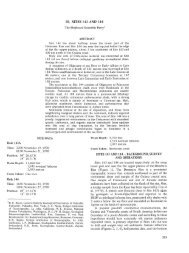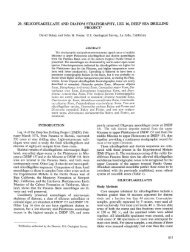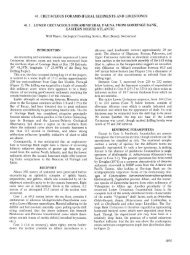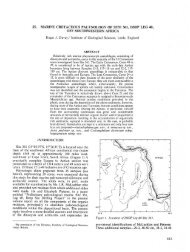16. Radiolaria - Deep Sea Drilling Project
16. Radiolaria - Deep Sea Drilling Project
16. Radiolaria - Deep Sea Drilling Project
You also want an ePaper? Increase the reach of your titles
YUMPU automatically turns print PDFs into web optimized ePapers that Google loves.
M. G. PETRUSHEVSKAYA, G. E. KOZLOVA<br />
Desmospyris sp. aff. D. lata<br />
(Plate 38, Figure 1)<br />
IDendrospyris acutis Goll 1968, p. 1419, pi. 173, figs. 7-9, 12.<br />
Giraffospyris lata Goll, 1969, p. 334, pi. 58. figs. 22, 24-26.<br />
In our specimens the number of pores was the same as in D. lata,<br />
but the entire outline of the test was more similar to that of D.<br />
acutis (though in some specimens the outline of the shell was<br />
intermediate between D. lata and D. acutis). Maybe this Paleocene<br />
species was ancestral to the two Eocene species described by Goll.<br />
Paleocene.<br />
Genus DENDROSPYRIS Haeckel, sens. str.<br />
Dendrospyris Haeckel, 1881, p. 441; 1887, p. 1038; Campbell,<br />
1954, p. 112; Goll, 1968, p. 1417, part. Type species<br />
Ceratospyris stylophora Ehrenberg, 1873 (1875, pi. 20, fig. 10).<br />
Giraffospyris Haeckel, 1881, p. 442; 1887, p. 1056; Campbell,<br />
1954, p. 114; Goll, 1969, p. 329, part. Type species Ceratospyris<br />
heptaceros Ehrenberg, 1873; 1875, pi. 20, fig. 2.<br />
Aegospyris Haeckel, 1881, p. 442; 1887, p. 1053; non Campbell,<br />
1954, p. 112; Riedel, 1959b, p. 6. Type species Aegospyrys<br />
aegoceras Haeckel, 1887, pi. 95, fig. 10.<br />
Triospyrium Haeckel, 1887, p. 1030; Campbell, p. 112. Type<br />
species Ceratospyris furcata Ehrenberg, 1873; 1875, pi. 20,<br />
fig. 8.<br />
Diagnosis. Test consists of one segment, a thick-walled cephalis.<br />
Large pores situated symmetrically on both sides of the sagittal ring.<br />
(Plate 39, Figure 22). The latter is connected with or included in the<br />
cephalic wall. The mouth constricted. Six feet are directed<br />
downwards, two of them being stronger than the others. Several<br />
horns on the cephalis.<br />
Dendrospyris didiceros group<br />
(Plate 40, Figure 12)<br />
Ceratospyris didiceros Ehrenberg, 1873, p. 228; 1875, pi. 21, fig. 6.<br />
Ceratospyris longibarba Ehrenberg, 1873, p. 219; 1875, pi. 21,<br />
fig- 2.<br />
Ceratospyris heptaceros Ehrenberg, 1873, p. 219; 1875, pi. 20,<br />
fig. 2.<br />
Giraffospyris didiceros (Ehrenberg) Goll, 1969, p. 332, pi. 60, figs.<br />
5-7, 9, part; Riedel and Sanfilippo, 1970, pi. 5, fig. 5, part.<br />
Eocene-Oligocene?<br />
Dendrospyris pododendros (Carnevale) group<br />
(Plate 39, Figures 26-28)<br />
Tessarospyris pododendros Carnevale, 1908, p. 28, pi. 3, fig. 18.<br />
Dendrospyris pododendros (Carnevale) Goll, 1968, p. 1422, pi. 174,<br />
figs. 1-4.<br />
Early and Middle Miocene.<br />
Genus PETALOSPYRIS Ehrenberg<br />
Petalospyris Ehrenberg, 1847, p. 54; Haeckel, 1881, p. 443; 1887,<br />
p. 1059; Bütschli, 1882, p. 510; Campbell, 1954, p. 114;<br />
Petrushevskaya, 1971b, p. 249. Type species Petalospyris<br />
foveolata Ehrenberg, 1854, pi. 36, fig. 14.<br />
This genus is very closely related to Dendrospyris. The difference<br />
lies in the wide-open mouth of the test, the legs going first laterally,<br />
and only then they may be curved and directed downwards. The<br />
legs, about six in number, are more or less strong, cylindrical.<br />
Petalospyris triceros (Ehrenberg) group<br />
(Plate 40, Figure 9)<br />
Ceratospyris triceros Ehrenberg, 1873, p. 220; 1875, pi. 21, fig. 5.<br />
Tristylospyris triceros Ehrenberg) Riedel, 1959a, p. 292, pi. 1,<br />
figs. 7, 8; Riedel and Sanfilippo, in press, pi. 3A, figs. 11, 12;<br />
Moore, in press, pi. 6, figs. 1-3.<br />
Six divergent feet, three of them being stronger than the others.<br />
Eocene-Oligocene.<br />
All of the feet are weak.<br />
Oligocene.<br />
Petalospyris sp. E<br />
(Plate 40, figure 1)<br />
Dorcadospyris(?) or Petalospyris(?) ateuchus (Ehrenberg)<br />
Ceratospyris ateuchus Ehrenberg, 1873, p. 218.<br />
532<br />
Cantharospyris ateuchus (Ehrenberg) Riedel, 1959, p. 294, pi. 22,<br />
fig. 3, 4.<br />
Dorcadospyris ateuchus (Ehrenberg) Riedel and Sanfilippo, 1970, p.<br />
253, pi. 15, fig. 4; Moore, in press, pi. 8, figs. 1, 2.<br />
Two of the feet are stronger than the others as in Dorcadospyris,<br />
but all feet are divergent as in Petalospyris, and they are not inclined<br />
to form any ring.<br />
Oligocene.<br />
Genus DORCADOSPYRIS Haeckel<br />
Dorcadospyris Haeckel, 1881, p. 441; 1887, p. 1040; Campbell,<br />
1954, p. 112; Goll, 1969, p. 335, part. Type species<br />
Dorcadospyris dentata Haeckel, 1887, pi. 85, fig. 6.<br />
Gamospyris Haeckel, 1881, p. 441; 1887, p. 1042; Campbell, 1954,<br />
p. 112. Type species Gamospyris circularis Haeckel, 1887, pi. 83,<br />
fig. 19.<br />
Stephanospyris Haeckel, 1881, p. 441; 1887, p. 1042; Campbell,<br />
1954, p. 112. Type species Stephanospyris cor data Haeckel,<br />
1887, ρl. 85, fig. 10.<br />
Wrachiospyris Haeckel, 1881, p. 441; 1887, p. 1037; Campbell,<br />
1954, p. 112. Type species Ceratospyris ocellata Ehrenberg,<br />
1873; 1875, pi. 20, fig. 5.<br />
This genus is closely related to Petalospyris. The only difference<br />
lies in the development of the feet. In Dorcadospyris two of the feet<br />
are stronger than the other four, and these two legs are inclined to<br />
be joined to form a ring.<br />
Dorcadospyris sp. K<br />
(Plate 40, Figure 5)<br />
Two feet form a complete ring. The four other feet are rather<br />
strong and long. It is very much the same as inZ). spinosa Moore (in<br />
press, pi. 7, figs. 2-5), but the feet are smooth, without horns.<br />
Oligocene.<br />
Dorcadospyris simplex (Riedel)<br />
(Plate 40, Figure 11)<br />
See Riedel and Sanfilippo, 1970, p. 523, pi. 15, fig. 6.<br />
Miocene.<br />
Dorcadospyris dentata Haeckel<br />
See Goll, 1969, p. 338, pi. 60, figs. 8, 10-13.<br />
Miocene.<br />
Dorcadospyris alata (Riedel)<br />
See Riedel and Sanfilippo, 1970, p. 523, pi. 14, fig. 5.<br />
Miocene.<br />
Genus PATAGOSPYRIS Haeckel<br />
Patagospyris Haeckel, 1881, p. 443; 1887, p. 1087; Campbell, 1954,<br />
P. 116; Petrushevskaya, 1971b, p. 248. = Petalospyrella Haeckel,<br />
1887, p. 1060; Campbell, 1954, p. 114. Type species,<br />
Petalospyris confluens Ehrenberg, 1873; 1875, pi. 22, fig. 5.<br />
All features are nearly the same as in Petalospyris, but the feet<br />
are more numerous and flat (not cylindrical).<br />
Patagospyris argisca (Ehrenberg)<br />
(Plate 40, Figure 8)<br />
Petalospyris argiscus Ehrenberg, 1873, p. 246; 1875, pi. 22, fig. 1.<br />
Dorcadospyris argisca (Ehrenberg) Goll, 1969, p. 336, part.<br />
The specimen illustrated by Goll has no sagittal constriction,<br />
while the sagittal constriction is distinct in the specimens from<br />
Ehrenberg's and from our material.<br />
Eocene.<br />
Patagospyris pentas (Ehrenberg)<br />
(Plate 39, Figures 32, 33)<br />
Petalospyris pentas Ehrenberg, 1873, p. 247; 1875, pi. 22, fig. 11.<br />
Eocene.<br />
Family ACANTHODESMIIDAE Haeckel<br />
Haeckel, 1862, p. 265;Hertwig, 1879, p. 68; Bütschli, 1882, p. 495;<br />
Riedel 1967b, p. 296, part; Petrushevskaya, 1971a, p. 990;<br />
1971b,p.260.<br />
Stephoidea Haeckel, 1887, p. 931.



